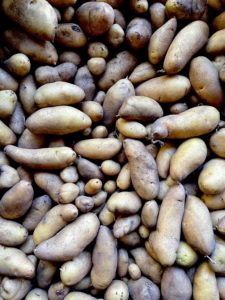Fun Facts for the Vegetable Literate

“FAQs” are “frequently asked questions,” and the reason they are frequently asked is because EVERYBODY wants to know the answers. Amaze your friends with your produce fluency by arming yourself with these fun facts!
1. “Why are these carrots round?”
Round carrots are a type known in the trade as “Paris Market carrots.” Back in the day, there were no long, orange carrots as we know them today. Europe had a native white carrot. In Western Asia there were red carrots, purple carrots, and even black carrots. When European farmers found out about the colored Asian carrots they began crossing them with their native white carrots. French farmers were especially active in this regard, and many of the different classes of modern carrot have French names, like Chantenay, Danvers, Nantes, and the Paris Market. Long, skinny carrots, like the Nantes types, enjoy a loose, sandy soil that lets them stretch their roots out. Farmers in the countryside outside of Paris naturally looked to that great city as a market for their produce, but much of the agricultural lands in that region are composed of sticky, heavy clay; exactly what a typical carrot doesn’t hope for. The carrot type that was developed to thrive around Paris was stubby and round, so it didn’t need to pierce deep into the earth, but instead formed a root ball that grows fatter and fatter, like a beet. I grow both long, skinny carrots and fat round ones, but at the moment our long, skinny carrots are being plagued by carrot maggots. I’m impressed with the Paris Market carrots because they seem almost entirely immune to this pest.
2. “What is Lovage good for?”
 Lovage is a member of the Umbelliferae- the carrot family- along with parsley, celery, cilantro, chervil, dill, fennel, anis, and cumin. Like its relatives, Lovage has a strong scent. And lovage is often used as a garnish the way so many of the other Umbelliferae are. I joke that a single bunch of lovage has as much flavor as a whole case of celery, And the flavor of lovage certainly is reminiscent of celery, but it’s a lot stronger; little goes a long way, but it does go well with tomatoes. If you read the small print on a can of V8 juice you’ll see that lovage is an ingredient. Lovage is also a good ingredient for tomato sauces and soups. Lovage even has a role in the execution of a perfect Bloody Mary. That piece of celery often found cluttering up a Bloody Mary? – the most original of all Bloody Mary recipes called for the drink to be sipped through a lovage straw. Lovage stems are hollow, and to sip the drink through a fresh cut stem imparts just enough of the herb’s warming flavor to compliment the tomato cocktail without overwhelming it, whereas celery is just a stick of irrelevant roughage. Because we’re so rich with ripe tomatoes right now – and tomato juice and crushed, jarred tomatoes, it seems like a good time to pick some lovage.
Lovage is a member of the Umbelliferae- the carrot family- along with parsley, celery, cilantro, chervil, dill, fennel, anis, and cumin. Like its relatives, Lovage has a strong scent. And lovage is often used as a garnish the way so many of the other Umbelliferae are. I joke that a single bunch of lovage has as much flavor as a whole case of celery, And the flavor of lovage certainly is reminiscent of celery, but it’s a lot stronger; little goes a long way, but it does go well with tomatoes. If you read the small print on a can of V8 juice you’ll see that lovage is an ingredient. Lovage is also a good ingredient for tomato sauces and soups. Lovage even has a role in the execution of a perfect Bloody Mary. That piece of celery often found cluttering up a Bloody Mary? – the most original of all Bloody Mary recipes called for the drink to be sipped through a lovage straw. Lovage stems are hollow, and to sip the drink through a fresh cut stem imparts just enough of the herb’s warming flavor to compliment the tomato cocktail without overwhelming it, whereas celery is just a stick of irrelevant roughage. Because we’re so rich with ripe tomatoes right now – and tomato juice and crushed, jarred tomatoes, it seems like a good time to pick some lovage.3. “Were “Russian Banana” potatoes created by mad scientists in Siberia genetically modifying a potato with DNA from a banana?”
a potato with DNA from a banana?”
 a potato with DNA from a banana?”
a potato with DNA from a banana?”No. The “Russian Banana” is a fingerling type potato, originally developed by Indigenous farmers in the Andes. No bananas were involved, or Russians either. The Andean farmers created a rainbow of different colored potatoes that come in many shapes. They were subsistence farmers, and weren’t thinking of clever marketing narratives. Instead, they developed potatoes that could thrive under many different ecological and climatic conditions. The so-called “Russian Banana” is a firm fleshed potato that can be happily made into potato salad and they roast up great too!
4. “How soon is dinner?”
It’ll go quicker if you help! Here; wash these potatoes. Scrub the round carrots; don’t peel them, and we’ll roast some of them with the potatoes. Trim two Lovage straws for our drinks and save the foliage for the potato salad we’re going to make tomorrow.
—© 2021 Essay by Andy Griffin. Photos by Andy Griffin and Starling Linden


